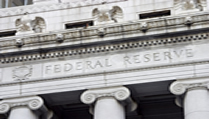 With well more than $170 trillion in debt linked to the London Interbank Offered Rate it’s no secret that regulators and investors will face headwinds as they try to disengage from the scandalized reference rate. But advocates for switching from Libor to new risk-free rate (RFR) offerings like the Federal Reserve’s Secured Overnight Financing Rate (SOFR) got a boost in the last month or so by two big entities offering securities linked to the Fed’s new rate. SOFR is a rate based on transactions in the US Treasury repo market.
With well more than $170 trillion in debt linked to the London Interbank Offered Rate it’s no secret that regulators and investors will face headwinds as they try to disengage from the scandalized reference rate. But advocates for switching from Libor to new risk-free rate (RFR) offerings like the Federal Reserve’s Secured Overnight Financing Rate (SOFR) got a boost in the last month or so by two big entities offering securities linked to the Fed’s new rate. SOFR is a rate based on transactions in the US Treasury repo market.
First up was Fannie Mae, which at the end of July issued what it billed as the “the market’s first-ever” SOFR securities. The three-tranche $6 billion SOFR debt transaction settled on July 30, 2018.
“With this milestone, our objective is to accelerate the development of the SOFR market and we encourage other issuers in the debt markets to follow,” Nadine Bates, Senior Vice President and Treasurer of Fannie Mae said in a statement. “As a member of the Federal Reserve’s Alternative Reference Rate Committee, we are honored to demonstrate our support to the ARRC in its tremendous efforts to help develop an alternative to USD LIBOR.”
Fannie Mae said there was strong demand for the issues but didn’t say who was interested.
Then this week the World Bank priced its first SOFR. The 2-year USD-denominated benchmark bond raised USD 1 billion from investors in the Americas and Europe. This is the first SSA-issued SOFR-linked bond and represents the second transaction in the market.
The World Bank said its offering “responds to investor demand for high quality assets and helps develop the market for SOFR.” It reported that there were orders for approximately $1.4 billion from 27 investors “representing central banks and official institutions (55.5%), and asset managers, insurance and pension funds (22.8%), and bank treasuries and corporates (21.7%).
The press release added a little umph to its announcement by including input from the Fed. “Given its global responsibilities, the World Bank’s decision to issue a SOFR note sends an important signal to market participants,” said Randal Quarles, Vice Chairman for Supervision, Federal Reserve Board. “SOFR is fast developing into a robust and durable reference rate that is a strong choice for a wide range of cash products.”
Banking regulators and central banks are keen on accelerating switch to new risk-free rates like SOFR and the UK’s sterling overnight index average (SONIA). The problem is Libor is deeply entrenched, both in institutional and retail loans. According to some estimates, there are $170 trillion of swap contracts alone still tied to Libor rate. Then there are the mortgage-backed securities that involve quite a few more trillions. The contracts for MBS provide a “fallback” clause if Libor is temporarily unavailable. But there’s probably nothing about the end of Libor, experts say. So it leaves a lot of haziness when it comes to the legal aspects, and some reports suggest issuers of MBS could be tangled up in years of litigation following the 2021 cutoff.
So there is work to be done – and perhaps a lot more new RFR-linked bond offerings – to come before investors and the market are entirely comfortable with leaving Libor behind.